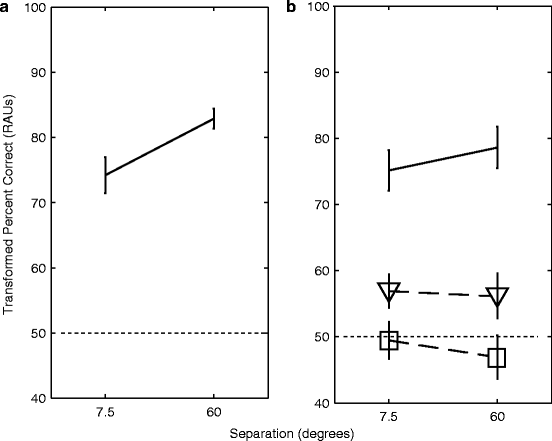Fig. 58.1
Mean percent correct performance, transformed into rationalized arcsine units (RAU; Studebaker 1985) and plotted as a function of the angular separation between primary and secondary talkers. Chance performance is indicated by dotted lines. For Panel a, all questions were from the primary talker. For Panel b, 70 % of the questions were from a primary talker and 30 % from a secondary. Solid lines show performance based on questions from the primary talker. Dashed lines show performance based on questions from the secondary talker
4 Experiment 2: Three Talkers
Stories from three female talkers were presented at 0°, ±7.5°, and ±60° relative to the midline, with the one on the midline labeled “primary.” Ss were a new set of 28 young, native English-speaking subjects with normal hearing. In the control condition (A), 12 Ss knew that 100 % of the questions would come from the primary talker. In the shared-attention condition (B), a different 16 Ss knew that a majority of the questions (actually, 60 %) would come from the primary talker, and the rest would be split evenly between secondary talkers (actually 20 and 20 %).
4.1 Result and Discussion
Figure 58.2 shows performance plotted as a function of the angular distance from the primary and two secondary talkers. Solid and dashed lines represent answers to questions from primary and secondary talkers, respectively. With distraction from both sides (2A), performance in the control condition shows more interference than in Fig. 58.1a. However, there was a significant spatial release from masking, i.e., better performance with separations of 60° (t(11) = −2.639, p = 0.027). Perhaps the small but insignificant release seen in Fig. 58.1a reflects a ceiling effect that hid a release from masking. Comparison of Fig. 58.2a, b shows that primary performance was not further compromised in the shared-attention task, though the seeming spatial release for the primary talker in Fig. 58.2b is not significant (t(15) = −1.157, p = 0.266). Post-session comments from some Ss said that one of the secondary talkers had a particularly “high-pitched” and “animated” voice that made her seem to stand out. Results here for secondary talkers are thus parsed into two dashed lines, one (triangles) for the more distinctive talker and one (squares) for the others. For the squares, performance did not differ from chance, but for the triangles, performance was better than chance (one tailed t(15) = 2.870, p = 0.0058).


Fig. 58.2




Mean percent correct performance, transformed into rationalized arcsine units (RAU; Studebaker 1985) and plotted as a function of the angular separation between primary talker at 0°. Chance performance is indicated by dotted lines. For Panel a, all questions were from the primary talker. For Panel b, 60 % of the questions were from the primary talker and 20 % from each of the two secondary talkers. Solid lines show performance based on questions from a primary talker and dashed lines show performance based on the secondary talkers. Additionally, Panel b divides secondary performance for the two different secondary talkers; these are plotted by triangles and squares
Stay updated, free articles. Join our Telegram channel

Full access? Get Clinical Tree


